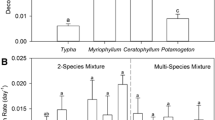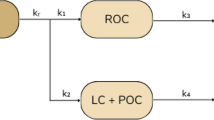Abstract
To understand the changes in chemical composition which may occur as an individual aquatic macrophyte decays, a species of tropical duckweed (Lemna paucicostata) was decomposed (aerobically and anaerobically) by its associated microbial population. Under anaerobic conditions, decomposition of the plant and microbial growth were very rapid. Shortchain carboxylic acids (C2-C5) and ammonia were generated in considerable amounts (reaching a maximum of ca. 30% by weight of original dry weight ofLemna after 71 days). In contrast, free sugars decreased, and amino compounds initially increased slightly and then decreased to the original levels. There were no physical or chemical indications of decomposition occurring under aerobic conditions. The likely biochemical pathways involved in anaerobic decomposition are discussed, and the results are compared with other anaerobic systems such as the rumen, sludge digestion, and aquatic sediments.
Similar content being viewed by others
References
Ansbaek, J., andBlackburn, T.H. 1980. A method for the analysis of acetate turnover in a coastal marine sediment.Microb. Ecol. 5:253–264.
Baldwin, R.L., Koong, L.J., AndUlyatt, M.J. 1977. The Formation and utilization of fermentation end-products: Mathematical models, pp. 347–391,in R.T.J. Clarke and T. Bauchop (eds.).Microbial Ecology of the Gut. Academic Press, London.
Barcelona, M.J. 1980. Dissolved organic carbon and volatile fatty acids in marine sediment pore waters.Geochim. Cosmochim. Acta 44:1977–1984.
Bastardo, H. 1979. Laboratory studies on decomposition of littoral plants.Pol. Arch. Hydrobiol. 26:267–299.
Calow, P. 1973. Field observations and laboratory experiments on the general food requirements of two species of freshwater snail,Planorbis contenus (Linn) andAncylusfluviatilis (Müll).Proc. Malacol Soc. London 40:483–489.
Calow, P. 1974. Evidence for bacterial feeding inPlanorbis contortus (Linn) (Gastropoda: Pulmonata).Proc. Malacol. Soc. London 41:145–156.
Cappenberg, T.E., Jongejan, E., andKaper, J. 1978. Anaerobic breakdown processes of organic matter in freshwater sediments, pp. 91–99, inProceedings of the International Microbial Ecology Symposium J.A.R. Miles and M.W. Loutit (eds.). Springer Verlag, Berlin.
Chang, S.-M., Yang, C.-C., andSung, S.-S. 1978. The effects of plant hormones on the cultivation and chemical composition ofLemnaceae.Bull. Inst. Chem., Acad. Sinica 25:19–34.
Durst, H.D., Milano, M., Kikta, E.J., Connelly, S.A., andGrushka, E. 1975. Phenacyl esters of fatty acids via crown ether catalysts for enhanced untraviolet detection in liquid chromatography.Anal. Chem. 47:1791–1801.
Elsden, S.R., andHilton, M.G. 1978. Volatile acid production from threonine, valine, leucine and isoleucine byClosiridia.Arch. Microbiol. 117:165–172.
Fenchel, T. M., andJørgensen, B.B. 1977. Detritus food chains of aquatic ecosystems: The role of bacteria.Adv. Microb. Ecol. 1:1–58.
Fevrier, A., Barbier, M., andSaliot, A. 1976. Molecules organiques dissoutes dans l'eau de mer: Utilisation de l'acide palimitique, de l'alcool cetylique et du dotriacontane par les invertebres marins.J. Exp. Mar. Biol. Ecol. 25:123–129.
Gauch, R., Leuenberger, U., andBaumoartner, E. 1979. Quantitative determination of mono-, di- and trisaccharides by thin layer chromatography.J. Chromatogr. 174:195–200.
Gocke, K. 1971. Untersuchungen über Abgabe und Aufnahme von Aminosäuren und Polypeptiden durch Planktonorganismen.Arch. Hydrobiol. 67:285–367.
Hartree, E.F. 1972. Determination of protein: a modification of the Lowry method that gives a linear photometric response.Anal. Biochem. 48:422–427.
Jabbar Muztar, A., Slinger, S.J., andBurton, J.H. 1978a. Chemical composition of aquatic macrophytes I. Investigation of organic constituents and nutritional potential.Can. J. Plant Sci. 58:829–841.
Jabbar Muztar, A., Slinger, S.J., andBurton, J.H. 1978b. II. Amino acid composition of the protein and non-protein fractions.Can. J. Plant Sci. 58:843–849.
Jabbar Muztar, A., Slinger, S.J., andBurton, J.H. 1978c, III. Mineral composition of freshwater macrophytes and their potential for mineral nutrient removal from lake water.Can. J. Plant Sci. 58:851–862.
Jabbar Muztar, A., Slinger, S.J., andBurton, J.H. 1979. IV. Carotenoids, soluble sugars and starch in relation to their pigmenting and ensiling potential.Can. J. Plant Sei. 59:1093–1098.
Jackson, P.C., andSt. John, J.B. 1980. Changes in membrane lipids of roots associated with changes in permeability.Plant Physiol. 66:801–804.
Jeris, J.S., andMcCarty, P.L. 1965. The biochemistry of methane fermentation using C14 tracers.J. Water Pollut. Control Fed. 37:178–192.
Joergensen, M.H. 1978. Anaerobic formation of volatile acids in a chemostat.Eur. J. Appl. Microbiol. Biotechnol. 6:181–187.
Lacey, J. 1979. Aerial dispersion and the development of microbial communities, pp. 140–170,in J.M. Lynch andN.J. Poole (eds.). Microbial Ecology: A Conceptual Approach. Blackwell, Oxford.
Lammens, E.H.R.R., andVan Der Velde, G. 1978. Observations on the decomposition ofNymphoides peltata (G. mel.) O. Kuntze (Menyanthaceae) with special regard to the leaves.Aquat. Bot. 4:331–346.
Lynch, J. M., andPoole, N.J. 1979. Microbiol Ecology: A Conceptual approach. Blackwell, Oxford.
Maser, M.D., andTrimble, J.J., III. 1977. Rapid chemical dehydration of biological samples for scanning electron microscopy using 2,2-dimethoxypropane.J. Histochem. Cytochem. 25:247–251.
Mason, C.F. 1974. Mollusca, pp. 555–591,in C.H. Dickinson and G.J.F. Pugh (eds.). Biology of Plant Litter Decomposition. Academic Press, London.
Miller, D., Brown, C.M., Pearson, T.H., andStanley, S.O. 1979. Some biologically important low molecular weight organic acids in the sediment of Loch Eil.Mar. Biol. 50:375–383.
Newell, R.C., Lucas, M.I., andLinley, E.A.S. 1981. Rate of degradation and efficiency of conversion of phytoplankton debris by marine microorganisms.Mar. Ecol. Prog. Ser. 6:123–136.
Patience, R.L., andThomas, J.D. 1982. Rapid concentration and analysis of short chain carboxylic acids: Variation on a theme.J. Chromatogr. 234:225–230.
Pimentel, D., andWhite, P.C. 1959. Biological environment and habits ofAustralorbis glabratus.Ecology 40:541–550.
Pomeroy, L.R. 1980a. Detritus and its role as a food source, pp. 84–102,in R.K. Barnes and K.H. Mann (eds.). Fundamentals of Aquatic Ecosystems. Blackwell, Oxford.
Pomeroy, L.R. 1980b. Microbial roles in aquatic food webs, pp. 85–109,in R.R. ColwellandJ. Foster (eds.). Aquatic Microbial Ecology (Proceedings of a Conference). University of Maryland Sea Grant Program, College Park, Maryland.
Poston, J.M. 1976. Leucine 2,3-aminomutase, an enzyme of leucine catabolism.J. Biol. Chem. 251:1859–1863.
Rosen, H. 1957. A modified ninhydrin colorimetric analysis for amino acids.Arch. Biochem. Biophys. 67:10–15.
Runquist, E.A., Abbott, E.H., Armold, M.T., andRobbins, J.E. 1981. Application of13C- nuclear magnetic resonance to the observation of metabolic interactions in anaerobic digestors.Appl. Environ. Microbiol. 42:556–559.
Russell, J.B., andHespell, R.B. 1981. Microbial rumen fermentation.J. Dairy Sei, 64:1153–1169.
Sansone, F.J., andMartens, C.S. 1981. Determination of volatile fatty acid turnover rates in organic-rich marine sediments.Mar. Chem. 10:233–247.
Sieburth, J.McN. 1975. Microbial Seascapes. University Park Press, Baltimore.
Skopintsev, B.A., Bikbulatov, E.S., Bikulatov, E.M., andMelnikova, N.I. 1979a. Change in the chemical composition of water and suspensions during decomposition of organic matter of phytoplankton under aerobic conditions.Tr. Inst. Biol. Vnutr. Vod. Akad. Nauk SSSR. 37:159–186.
Skopintsev, B.A., Bikbulatov, E.S., Bikbulatov, E.M., andMelnikova, N.I. 1979b. Change in the chemical composition of water and suspensions during decomposition of organic matter of phytoplankton under anaerobic conditions.Tr. Inst. Biol. Vnutr. Vod. Akad. Nauk SSSR 37:187–203.
Smock, L.A., andStoneburner, D.L. 1980. The response of macroinvertebrates to aquatic macrophyte decomposition.Oikos 35:397–403.
Sørensen, J., Christensen, D., andJørgensen, B.B. 1981. Volatile fatty acids and hydrogen as substrates for sulfate-reducing bacteria in anaerobic marine sediment.Appl. Environ. Microbiol. 42:5–11.
Southward, A.J., andSouthward, E.C.. 1970. Observations on the role of dissolved organic compounds in the nutrition of benthic invertebrates. Experiments on three species ofPoponophora. Sarsia 45:69–96.
Spoelstra, S.F. 1979. Volatile fatty acids in anaerobically stored piggery wastes.Neth. J. Agric. Sci. 27:60–66.
Standard Methods For The Examination Of Water And Wastewater. 1981. (15th ed.), pp. 360–361. American Public Health Association, American Water Works Association, Water Pollution Control Federation.
Tempest, D.W., andNeijssel, O.M. 1981. Metabolic compromises involved in the growth of micro-organisms in nutrientlimited (chemostat) environments, pp. 335–336,in A. Hollaender and R. Rabson (eds.). Basic Life Sciences. 18 (Trends in Biological Fermentation and Fuels Chemistry) Plenum Press, New York.
Testerman, J.K. 1972. Accumulation of free fatty acids from sea water by marine invertebrates.Biol. Bull. 142:160–177.
Thomas, J.D., Lough, A.S., andLodge, R.W. 1975. The chemical ecology ofBiomphalaria glabrata (Say), the snail host ofSchistosoma mansoni Sambon: The search for factors in media conditioned by snails which inhibit their growth and reproduction.J. Appl. Ecol. 12:421–436.
Thomas, J.D., Cowley, C., andOfosu-Barko, J. 1980. Behavioural responses to amino and carboxylic acids byBiomphalaria glabrata, one of the snail hosts ofSchistosoma mansoni, pp. 433–448,in R.A. Baker (ed.). Sixth International Symposium on Controlled Release of Bioactive Materials. Academic Press, New York.
Toerien, D.F., andHattingh, W.H.J. 1969. Anaerobic digestion. I. The microbiology of anaerobic digestion.Water Res. 3:385–416.
Uribelarrea, J.L., andPareilleux, A. 1981. Anaerobic digestion: microbial and biochemical aspects of volatile acid production.Eur. J. Appl. Microbiol. Biotechnol. 12:118–122.
Whatley, M.H., andSequeira, L. 1981. Bacterial attachment to plant cell walls.Recent Adv. Phytochem. 155:213–240.
Willoughby, L.G. 1974. Decomposition of litter in freshwater, pp. 659–681,in C.H. Dickinson and G.J.F. Pugh (eds.). Biology of Plant Litter Decomposition. Academic Press, London.
Willoughby, L.G. 1976. Freshwater Ecology. Hutchinson, London.
Zilic, Z., Blau, N., andKnob, M. 1979. Simple rapid method for the separation and quantitative analysis of carbohydrates in biological fluids.J. Chromatogr. 164:91–94.
Author information
Authors and Affiliations
Additional information
Part I of the Chemical Ecology of Freshwater Snail-Plant-Detritus Interrelationships.
Rights and permissions
About this article
Cite this article
Patience, R.L., Sterry, P.R. & Thomas, J.D. Changes in chemical composition of a decomposing aquatic macrophyte,Lemna paucicostata . J Chem Ecol 9, 889–911 (1983). https://doi.org/10.1007/BF00987813
Received:
Revised:
Issue Date:
DOI: https://doi.org/10.1007/BF00987813




